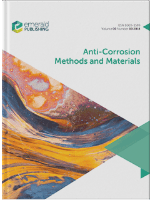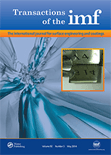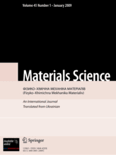
Protection of Metals and Physical Chemistry of Surfaces
Scope & Guideline
Fostering Collaboration in the Realm of Surface Chemistry
Introduction
Aims and Scopes
- Corrosion Science and Engineering:
Research on the mechanisms of corrosion, the development of corrosion inhibitors, and the evaluation of corrosion resistance in metals and alloys. - Adsorption Processes:
Studies focusing on the adsorption of various substances on metal surfaces, including the effects of surface modifications and environmental factors. - Surface Chemistry and Modification:
Investigation of surface properties and the development of coatings that enhance the performance and longevity of materials under corrosive conditions. - Nanotechnology in Materials Science:
Application of nanotechnology for creating advanced materials and coatings that exhibit improved mechanical, thermal, and chemical properties. - Electrochemical Methods:
Utilization of electrochemical techniques to analyze and enhance the protective properties of coatings and materials against corrosion. - Thermodynamic and Kinetic Studies:
Exploration of the thermodynamic principles governing adsorption and corrosion processes, emphasizing the importance of kinetics in material performance.
Trending and Emerging
- Green Chemistry and Eco-Friendly Inhibitors:
An increasing number of studies are focusing on environmentally friendly corrosion inhibitors derived from natural sources, reflecting a growing concern for sustainability in materials science. - Nanostructured Materials and Coatings:
Research involving nanostructured coatings is on the rise, showcasing their potential for enhanced properties such as improved corrosion resistance and mechanical strength. - Smart Coatings and Self-Healing Materials:
The emergence of smart coatings that can respond to environmental changes and self-healing materials is gaining traction, indicating a shift towards innovative solutions for corrosion protection. - Advanced Characterization Techniques:
There is a growing trend towards the use of sophisticated characterization methods (such as spectroscopy and microscopy) to better understand material behavior at the nanoscale. - Computational Materials Science:
The application of computational methods to predict material behavior and optimize coatings is increasingly prominent, demonstrating a blend of theoretical and practical approaches in research.
Declining or Waning
- Traditional Corrosion Testing Methods:
There has been a noticeable decrease in studies focused on conventional corrosion testing methods, as newer techniques and materials are being developed, emphasizing more advanced and efficient approaches. - Generalized Coating Technologies:
Research on broad, non-specific coating technologies is waning in favor of studies that target specific applications or materials, reflecting a trend towards more specialized and application-driven research. - Basic Electrochemical Analysis:
The focus on fundamental electrochemical analysis without application context is declining, as studies are increasingly oriented towards practical applications and real-world scenarios.
Similar Journals

ANTI-CORROSION METHODS AND MATERIALS
Exploring Advanced Materials for Lasting ProtectionANTI-CORROSION METHODS AND MATERIALS, published by EMERALD GROUP PUBLISHING LTD, is a leading journal in the fields of chemical engineering and materials science, focusing on innovative methods and materials for corrosion prevention and control. With its ISSN 0003-5599 and E-ISSN 1758-4221, this esteemed journal has been contributing to the academic community since its inception in 1954 and continues to be relevant through 2024. Despite its Q3 ranking in both Chemical Engineering and Materials Science categories, the journal plays a critical role in disseminating valuable insights and advancements, catering to a diverse audience of researchers, professionals, and students. Although the journal does not offer open access options, it remains a significant resource for those seeking to enhance their understanding of corrosion methodologies and to implement best practices in various industrial applications. With the recent Scopus rankings reflecting its impact, ANTI-CORROSION METHODS AND MATERIALS stands as a pivotal element of scholarly discourse in mitigating corrosion challenges in modern materials.

Russian Journal of Non-Ferrous Metals
Advancing the Frontiers of Metallurgical ScienceThe Russian Journal of Non-Ferrous Metals, published by PLEIADES PUBLISHING INC, serves as a vital resource for researchers and professionals in the fields of materials science and engineering. With a dual ISSN (1067-8212 for print and 1934-970X for online), this journal has been instrumental in disseminating cutting-edge research from 2007 to 2023. Specializing in the mechanics of materials, metals and alloys, and the study of surfaces, coatings, and films, it provides invaluable insights into the latest advancements and applications in these areas. Although currently categorized in the Q4 tier for mechanics of materials and surfaces, and Q3 for metals and alloys in the 2023 rankings, its commitment to quality research is reflected in its Scopus metrics, ranking it within the competitive spectrum of its fields. While not an open access journal, it remains a crucial academic platform for fostering knowledge exchange among professionals and scholars. By publishing high-quality articles, the Russian Journal of Non-Ferrous Metals contributes significantly to the ongoing dialogue in metallurgical science and engineering.

Portugaliae Electrochimica Acta
Catalyzing Discovery in Electrochemical ProcessesPortugaliae Electrochimica Acta is a distinguished journal dedicated to the field of electrochemistry, published by the SOCIEDADE PORTUGUESA ELECTROQUIMICA. With a notable ISSN of 0872-1904, this journal serves as a vital resource for researchers, professionals, and students interested in advancing their understanding of electrochemical processes. Though it is currently categorized in Q4 in the 2023 Electrochemistry rankings, the journal contributes significantly to the academic discourse from its base in Coimbra, Portugal. The journal's timeline spans actively from 2008 to 2025, ensuring a sustained engagement with emerging research. While the journal does not offer open access options, it remains an authoritative source noted for promoting innovative electrochemical research and fostering academic connections within the discipline. Researchers are encouraged to submit their findings and explore the latest contributions to this expanding field.

TRANSACTIONS OF THE INSTITUTE OF METAL FINISHING
Exploring the Frontiers of Metal Finishing InnovationTRANSACTIONS OF THE INSTITUTE OF METAL FINISHING, published by Taylor & Francis Ltd, is a premier journal dedicated to the field of metal finishing and surface engineering. With an ISSN of 0020-2967 and E-ISSN of 1745-9192, this journal has been a critical resource for researchers and practitioners since its inception in 1969. Covering a broad scope that includes condensed matter physics, mechanics of materials, and the intricate science of metals and alloys, TRANSACTIONS OF THE INSTITUTE OF METAL FINISHING has established itself within the academic community, currently holding Q2 and Q3 rankings across multiple relevant categories in 2023. While not openly accessible, the journal remains a vital compendium of innovative research findings and advancements, attracting contributors and readers eager to explore cutting-edge developments in metal finishing techniques and applications. The insightful articles published here cater to a wide audience, including industry professionals, academic researchers, and students, who seek to improve their understanding of materials science and engineering practices.

Surfaces
Transforming Perspectives on Material InteractionsSurfaces is an esteemed academic journal published by MDPI in Switzerland, operating as an open access platform since 2018. With an E-ISSN of 2571-9637, this journal focuses on the interdisciplinary advancements in the fields of chemistry, materials science, and physics, particularly in the domain of surfaces and interfaces. As a testament to its scholarly impact, Surfaces is ranked in the second quartile for multiple categories as of 2023, including Chemistry (miscellaneous), Materials Science (miscellaneous), Surfaces and Interfaces, as well as Surfaces, Coatings and Films, showcasing its relevance within these disciplines. Researchers and professionals seeking to disseminate and acquire knowledge on the latest innovations can benefit from the journal's rigorous peer-review process and commitment to quality, ensuring visibility and accessibility for current developments in surface technology and material interactions. With a growing archive from 2019 to 2024, Surfaces stands out as a vital resource for the academic community.

METALS AND MATERIALS INTERNATIONAL
Pioneering research at the intersection of science and engineering.METALS AND MATERIALS INTERNATIONAL, published by the Korean Institute of Metals and Materials, is a prestigious journal dedicated to the advancement of research in the fields of materials science and engineering. With an ISSN of 1598-9623 and a robust e-ISSN of 2005-4149, this journal has established itself as a crucial platform for disseminating innovative findings and key advancements that span condensed matter physics, materials chemistry, mechanics of materials, and the technology of metals and alloys. Its Q1 rankings in multiple categories attest to its high impact and relevance in the academic community, placing it among the top journals in its fields with Scopus rankings that reflect a strong international footprint. Here, researchers, professionals, and students can access cutting-edge research and insights, fostering collaboration and exploration of new materials and their applications. With a commitment to excellence and a convergence of knowledge from 1996 to 2024, METALS AND MATERIALS INTERNATIONAL continues to enhance our understanding of materials and their transformative impact on technology and engineering.

MATERIALS SCIENCE
Exploring Breakthroughs in Materials Research.MATERIALS SCIENCE, a prominent journal published by SPRINGER, serves as a vital resource for researchers, professionals, and students in the fields of materials science, mechanical engineering, and condensed matter physics. With its ISSN 1068-820X and E-ISSN 1573-885X, this journal has been dedicated to sharing innovative research since its inception in 1993, and it continues to publish groundbreaking findings through 2024. Although it operates as a traditional subscription-based journal, its ranking in the Q3 quartile across multiple scientific categories, including Condensed Matter Physics, Materials Science, Mechanical Engineering, and Mechanics of Materials, signifies its relevance and impact in the academic community. Notably, its Scopus classifications reveal a competitive standing among its peers, ranking within the 25th to 33rd percentiles across various engineering and physics disciplines. The journal remains a key platform for disseminating valuable insights, fostering collaboration, and advancing the understanding of materials science.

Tungsten
Advancing the frontiers of tungsten research.Tungsten, published by SpringerNature, is a prestigious academic journal dedicated to advancing the field of materials science with a specific focus on tungsten and its diverse applications. Launched in 2019, the journal has quickly established itself as a leading resource in its domain, achieving a remarkable Q1 ranking across multiple categories including Materials Chemistry, Materials Science (miscellaneous), Metals and Alloys, and Surfaces, Coatings and Films. With robust performance reflected in its Scopus rankings—holding significant positions such as rank #20 in Metals and Alloys (88th percentile)—Tungsten serves as a vital platform for researchers and professionals seeking to disseminate innovative findings and foster collaboration in the materials science community. Although not an Open Access publication, this journal offers a well-curated collection of high-quality research articles, reviews, and technical notes aimed at driving forward the understanding and application of tungsten in various scientific sectors. Operating out of the United States, Tungsten is committed to providing an essential resource for academia and industry alike, making a significant contribution to the evolving landscape of materials research.

Corrosion Science and Technology-Korea
Navigating the complexities of corrosion for engineering excellence.Corrosion Science and Technology-Korea, published by the CORROSION SCIENCE SOC KOREA, is a pivotal journal dedicated to the exploration and advancement of knowledge in corrosion science, particularly within the context of materials performance and maintenance. Established to foster innovation and collaboration among scholars in South Korea and beyond, this journal focuses on areas such as electrochemistry, metal alloys, and surface coatings, catering to a diverse audience of researchers, professionals, and students in materials science and chemistry. Despite its current quartile rankings, including Q4 in Electrochemistry and Q3 in various materials-related categories, the journal aims to enhance its visibility and impact in the scientific community by publishing high-quality research and reviews. With its ISSN 1598-6462 and E-ISSN 2288-6524, Corrosion Science and Technology-Korea is committed to contributing to the understanding and mitigation of corrosion issues, thereby promoting sustainability and longevity in engineering applications.

Journal of Coatings Technology and Research
Advancing the Future of Coatings TechnologyThe Journal of Coatings Technology and Research, published by Springer, stands as a vital resource for researchers and professionals in the fields of materials science and chemistry. With an ISSN of 1547-0091 and an E-ISSN of 1935-3804, this journal is recognized for its significant contributions to the study of coatings technology, encompassing diverse aspects from surfaces and interfaces to colloids and surface chemistry. Currently holding a 2023 Impact Factor that places it in the Q2 and Q3 quartiles across several categories—including Chemistry and Colloid and Surface Chemistry—the journal serves as an essential platform for disseminating innovative research. Its accessibility options cater to a broad audience, ensuring that both established scholars and emerging researchers can engage with the latest findings. Since its inception in 2004, the journal has continued to foster advancements in coatings technologies, promoting sustainable practices and novel applications across industries.